
|   |

|   |
Dance Encore! - Janani Murali e-mail: janani.meenakshi@gmail.com Photos courtesy: CNB February 25, 2021 For almost a year now, the digital medium has become the adoptive home of the arts. Much has been written and discussed about the content of online performances and its presentation. And within a short span of a year, online streaming of performances or events has seen much evolution. While individuals and institutions find themselves at different junctures on this evolution curve, some events stand out for the clarity and conviction that they carry in the digital medium. The eleventh Chinmaya Naada Bindu Festival was one such. The Chinmaya Naada Bindu Festival has come to be known as a landmark event in India's cultural calendar, bringing some of the best performers to share their art at the Chinmaya Naada Bindu Ashram in Kolwan near Pune. In its 11th edition this year, the festival went online. Curated over 7 days from 10th to 16th February 2021, the days were packed with discourse and meditation in the morning, mid-day talks and interactive games and music and dance 'Encore' recitals in the evening. Realising that engaging with a packed schedule such as this one may be challenging for many, the festival organisers have enabled registered audiences to view all of these sessions until the end of February 2021. So if you haven't picked this festival to watch over the past weeks, here is why you should. 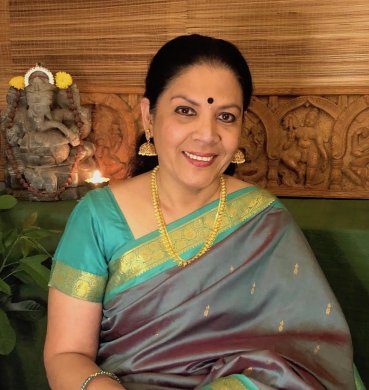 Ramaa Bharadvaj 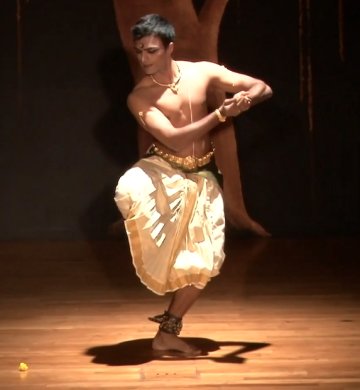 Parshwanath Upadhye As enriching as each of the sessions were, I choose to present here a detailed account of the dance sessions and what I as a dancer observed as the high points of this edition. Curated by Ramaa Bharadvaj, the Dance Encore events presented excerpts of performances from previous years that were noteworthy and deservedly received an 'Encore' from the audience. Each of the featured artistes and dance companies have received critical acclaim the world over and many of us have had the privilege of watching them in live performances and being drawn in by the impact they generate with their audiences. Since the excerpts presented in this festival were not specially recorded for the online platform, but rather were recordings of live performances, one would think that a telecast might diminish the impact of the live performance. Ramaa Bharadvaj seems to have foreseen this challenge and has taken the care to personally edit performances in a way that the online audience is glued in too. Not wanting to simply compile a list of favourite performances but in fact seeing the need to set context and curate the show, Ramaa strung the performances together with wit and charm that is characteristic of her presentations. As with all auspicious beginnings, day 1 of Dance Encore on 12th February began with a propitiation to the Lord of all beginnings - Ganesha- by Parshwanath Upadhye and Punyah Dance Company. Presented in Bharatanatyam, it recounted the symbolism of Ganesha and went on to narrate the story of how Ganesha got his elephant head. The presentation brought out beautifully some key innovative moments of the choreography. Following this, Ramaa chose to present Mythili Prakash's rendition of a natyageet "Rusili Radha Rusla Madhav." Accompanied by her brother Aditya Prakash on vocals and a collaborating orchestra, Mythili sketched the plight of Brindavan when Radha and Krishna get into an argument and refuse to talk to each other. Do Krishna and Radha finally make peace? Mythili drew the abhang to a close on an endearing note. From spring time in Brindavan to the monsoons of the land, the next presentation was of 'Varsha' by the popular Kathak duo, Nirupama and Rajendra. Set to instrumental music composed by Praveen Godkindi, the various hues of the skies, the clouds, the patter of raindrops, the blossoming of love and the dance of peacocks all came to life on a vibrant canvas. 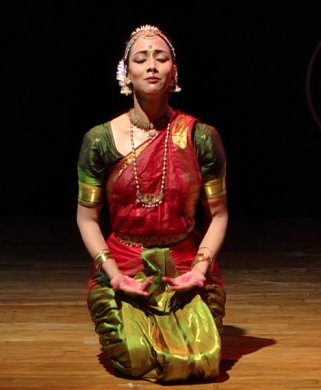 Mythili Prakash 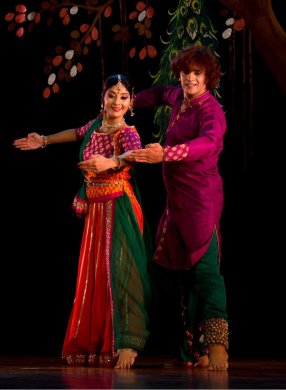 Nirupama and Rajendra Shankar Kandasamy of Temple of Fine Arts, KL, Malaysia, took the audience on a very different but equally vibrant journey through a Nindastuti set in the winter of Chidambaram! The symbolism of Nataraja and the esoteric significance therein is the subject of scholarly enterprise but here the poet asks several humorous questions on why Shiva stands with his left foot lifted off the ground. Through various popular tales of the puranas, the poet asks if Shiva probably sprained his foot while dancing or in his encounter with Yama or tripped while being a messenger for his beloved devotee or worse still probably just felt very cold during the abhishekha and couldn't place his foot down. The theme of the evening was built on existing performances cleverly, keeping audiences on track and gearing them up for what was in store next. A befitting finale to the first Dance Encore was a crisp abridged version of Vaibhav Arekar's 'Shrimant Yogi' tracing the events that shaped Chatrapati Shivaji's kingship and his ideology. Brought to life by the Sankhya Dance Company, the dancers created exhilarating visuals. Having watched the premiere of this production a few years ago, the rasika in me was thrilled that the clarity of sequence and continuity had not been marred in any way by the editing, but in fact the entire production had been encapsulated effectively. 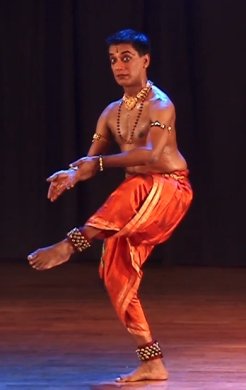 Shankar Kandasamy 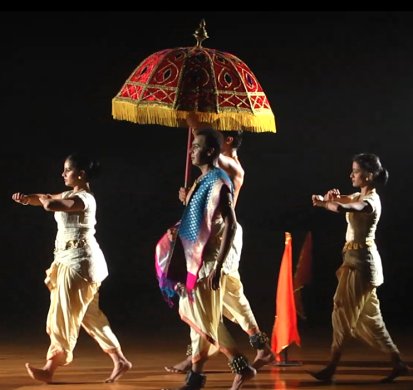 Shrimant Yogi If Day 1 of Dance Encore was a jubilant, vibrant celebration of dance, Day 2 of Dance Encore on 14th February 2021 offered an eclectic mix of the colourful, the introspective and the spiritual. The Ramayana is our legacy, continuing to thrive in its various versions across India and South-East Asia. "The Ramayana as told amongst the Bhils of India have no war sequence. As a community that does not believe in warfare, their version of the Ramayana ends with Ravana having a change of heart and returning Sita to Rama," says Ramaa as an introduction to a Ramayana Montage, drawing attention to how the epic over centuries continues to be integrated into every living culture. The montage itself brought three distinct performance styles and narratives together. 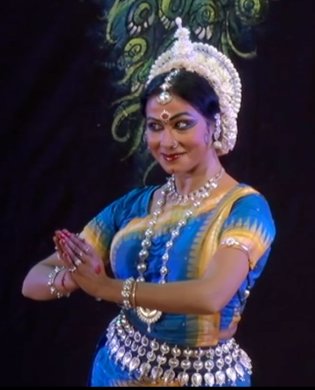 Sujata Mohapatra 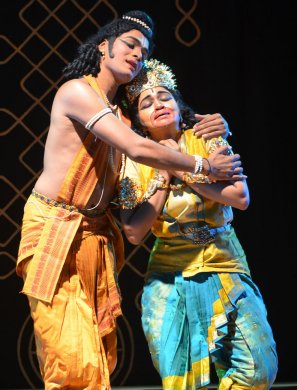 Bharatanjali ensemble Acclaimed Odissi exponent Sujata Mohapatra presented the Aranya Kandam, describing the events that unfold in the forest leading to the abduction of Sita. With a meticulously composed music score to accompany her abhinaya, Sujata characterised Sita, the golden deer and Ravana with subtlety and clarity. The Sundara Kandam which translates to 'the beauteous chapter' was brought to life by Anita Guha's Bharatanjali. Hanuman in Lanka is the epitome of valour and piety. Through dramatic visuals, with a pinch of humour, the dancers elaborated on Hanuman's encounter with Lankini, Sita and Ravana. The episode concluded with Hanuman returning to Rama with Sita's Chudamani and the Vanara Sena readying for battle. A contrast to the colourful imagery of the Sundara Kandam was a emotionally charged theatrical presentation of Mandodari's lament from the Yuddha Kandam (Chapter on the War) of Ramayana. Dr. Gowri Ramnarayan, Founder of JustUs Repertory, presented this rarely acknowledged woman from the epic - a woman chaste, brave and wise. The Ramayana, in its several thousand versions across the subcontinent has captured the imagination of people generation after generation. The three presentations within this Ramayana Montage were proof of the distinctly different voices and unique perceptions that we revel in. 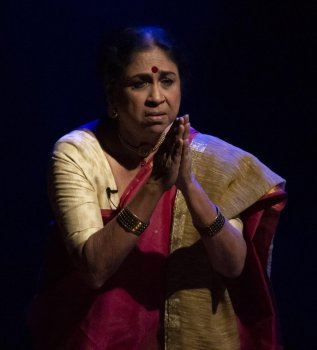 Gowri Ramnarayan 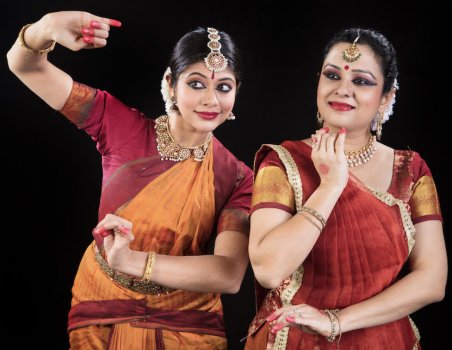 Dakshina Vaidyanathan Baghel & Monisa Nayak Two dance legends passed on in 2020 - Dr. Sunil Kothari, dance historian, scholar and critic and Astad Deboo, often referred to as the Father of Indian Contemporary Dance. Having had a long standing professional relationship with both these legends and an endearing friendship, it was only appropriate that Ramaa led the audience in homage to these two legends. Paying her respects to yet another legend in the world of music and dance, Pt Ravi Shankar, the next segment brought a jugalbandi by Dakshina Vaidyanathan Baghel in Bharatanatyam and Monisa Nayak in Kathak. Choreographed by the celebrated artiste Rama Vaidyanathan, the jugalbandi was set to instrumental music composed by Pt Ravi Shankar. Commissioned by the Naada Bindu Festival to mark the centenary year of Pt. Ravi Shankar, the Jazz inspired music presented an interesting springboard for both the dance forms. While presenting even one of these dance forms to a music track such as 'Jazzmine' could have proven challenging, the mastery over the craft of the choreographer and the intuitive sensibilities of the performers came forth in creating a noteworthy performance. Bringing Day 2 Dance Encore to a close was Mythili Prakash's poignant 'Benediction'. Set to Sufi music and rendered by flautist Mahesha Swamy, this excerpt attempted to take the dance and the experience beyond familiar grammar and content. A celebration of a universal need to seek the Divine was indeed a befitting end to the evening. Besides the performances, the other session on dance was a talk and demonstration by Mandakini Trivedi as part of the 'Kaladrishti' series of multi-dimensional lectures on insight into the arts. On day 2 of the festival, Mandakini Trivedi presented her talk on 'The Yantra Dances - a look at classical Indian dance as a parallel to yoga.' Classical Indian dance has often been equated to or compared to Yoga in several instances, but rarely does one ever understand these 2 terms holistically and what a comparison really means. Mandakini Trivedi, a dancer, scholar and writer brought together these 2 terms to explain the relevance of each to the other, what 'yogic' refers to and what of dance becomes yogic. Likening dance to the human body, she drew parallels between the various layers that conceal the vital organs in the body and the various metaphors and subtexts that hold within philosophical essence in the arts. The Mandala, an aesthetic understanding of the body, its movement and the creation of dance, world views, cultural intricacies and reflections therein were all elaborated on. She concluded with an excerpt from performance in praise of the Mother goddess. Curated by Ramaa Bharadvaj, the talk offered an insight into years of inter-disciplinary understanding- one that is vital to the growth of any student of the arts. For a festival that brought together diverse content of high calibre, I ask Ramaa Bharadvaj what her biggest takeaway is. "We created more than 5 times viewership for the work of the artists, than in our live festival. That's a good thing. But it was tremendous amount of work for me because the digital curator actually becomes a prominent and significant "performer". I had to also act as a 'director' of this event, and think about transition between pieces, continuity in idea, audience friendliness, adding to the performance viewing with contextual insights and thoughts and such. Otherwise, why should people watch these artistes in this festival, and under my curation rather than on Youtube? But, personally, I will never consider that a digital event could substitute the experience of a live event," says Ramaa, with much passion. Here is hoping the twelfth Chinmaya Naada Bindu festival offers a live experience. 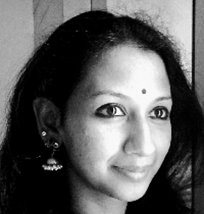 Janani Murali is a dancer, writer, biologist and ecoprenuer. She is Associate Artistic Director of Padmalaya Dance Foundation, Bangalore, and Executive Member of International Dance Alliance, Bangalore Chapter. |